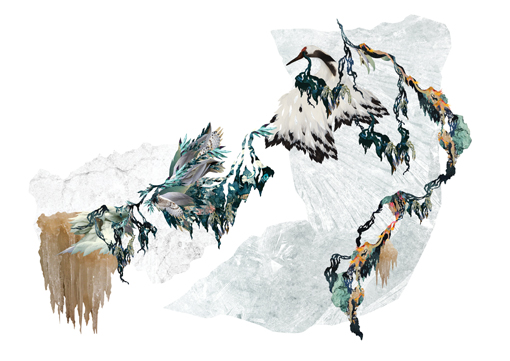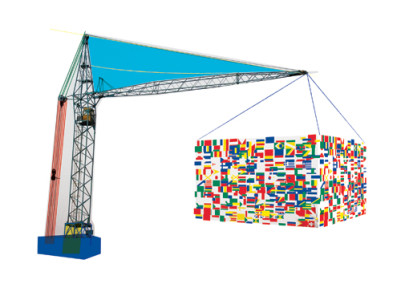THE TWO POLES | Al di là del Mondo degli Opposti

text Enrico Pieraccioli and Claudio Granato illustrations Elisa Vendramin
A hallucination. Or maybe a delirium. Being in a totally white cold landscape, real and alive as only nature can be. Apparently an inhospitable and hostile place able to make you feel at one with it and at the same time part of everything.
Totally immersed and at the center of a borderless landscape where the eye does not perceive an end, a limit, a border, in an area of Earth that has no language and does not have a flag.
Where?
At the poles.
But which of the two poles?
In both cases, the features are similar, as are the feelings between surprise and dismay, bewilderment and confusion.
How can two territories that are opposite to each other, create a sense of loss and orientation so as to not know whether you are at the north or south? A show at the antipodes that suggests the usual scene.
As a Déjà vu.
The alienation brings to mind what has already been read:
“…The notion that all opposites are polar, that light and dark,winning and losing, good and evil, are merely different aspectsof the same phenomenon, is one of the basic principles of theEastern way of life. Since all opposites are interdependent, their conflict can never result in the total victory of one side, but will always be a manifestation of the interplay between the two sides. In the East, a virtuous person is therefore not one who undertakes the impossible task of striving for the good and eliminating the bad, but rather one who is able to
maintain a dynamic balance between good and bad.
This notion of dynamic balance is essential to the way in which the unity of opposites is experienced in Eastern mysticism. It is never a static identity, but always a dynamic interplay between two extremes. This point has been emphasized most extensively by the Chinese sages in their symbolism of the
archetypal poles yin and yang. They called the unity lying behind yin and yang the Tao and saw it as a process which brings about their interplay: That which lets now the dark, now the light appear is Tao…”
From “The Tao of Physics” by Fritjof Capra
Aware of being part of everything without having to wonder whether being yin or yang, if being in the North or South you feel part of that balance, and the only thing to understand and analyze are the differences.The pole. The only part of the Earth where there are no seasons, or rather where they last only two; winter and summer, darkness and light. On one side dark, on the other light, and vice versa.
The South Pole, an area of land, covered with ice up to about three thousand meters above sea level; the North Pole a landless Earth, made only of solid water that can melt and freeze constantly changing its structure. The only point of the globe where in recent times a climate paradox is taking place. The constant rise of the Earth’s temperature is causing the ice banks of the North Pole to melt, while on the contrary the ice of the South Pole is increasing, albeit non-proportionally.
Yet the situation will tend to change rapidly. Climate models indicate an increase in carbon dioxide in the atmosphere even for the present century, and soon the melting glaciers from the ocean water will weigh on the amount of snow that falls on the Antarctic. This condition, which could come true within a few decades, will lead to a reversal of the trend of Antarctic ice to grow and will therefore lead to a situation that will be balanced with the North Pole.
And this change brings with it the inevitable appetite of Governments and corporations, as a result of a civilization based on speculation, which do not lose the opportunity to take advantage of the situation and who see in the disappearance of the ice of the True North upcoming business opportunities to create new naval and air routes. For these reasons the States that border with the Arctic are preparing to make the most of this precious and delicate ecosystem that is on it’s knees, leaping into a real race to conquer the North Pole. Russia, USA, Norway, Denmark and Canada for some time are playing a game of property claims and appeals. We will therefore have a chance to see in a few years at the expense of Arctic habitats, ports and airports in those lands on the edge of the world. Not only industrial fishing fleets without control or expeditions in search of gas and black gold, but even entire commercial runways capable of shaking an entire global economic system.
Global warming, however, is bringing to life one of the northernmost lakes in the world. The Kaffeklubben was repopulated by microscopic algae, diatoms, that have resurfaced after more than two thousand years.
And if the reappearance of these forgotten life forms bring with them a future of the species?
Evolution or decline?
And whilst the advancing of mankind increases in proportion to the melting of the North pole, on the opposite side of the world a “smart” colonization of about four thousand people is taking place in the summer months in the icy Antarctic Lands. Because of the cold and funds running short, for only five months a year, researchers and scientists are studying one of the purest places on Earth. Water and air of the South as samples to be studied, and the discovery of a sub glacial Lake at three thousand meters below the Antarctic has become the promise and hope for science, which is equal to the conquest of the Moon in the 1960s. So the Lake Vostok this lost world that has remained as it was twenty million years ago, is an ecosystem that brings various life forms, plants, animals and microbes, with a perfect climate and pure water. But these forms of life, which could be considered totally alien to us, can be a problem. A bacteriological agent from Earth could contaminate and exterminate the biology of the Lake in a few minutes, destroying the underground world; likewise an agent from the Lake, unknown to our environment and potentially dangerous could jeopardise and cause unpredictable problems throughout the South Pole, but even worse for the entire Planet.
And if contamination was bijective and neither of these two parallel universes could be saved?
Decline or evolution?
There are neither losers or winners, but simply a condition of equilibrium, of eternal stasis that repeats and repeats.
The battle between equal but opposite, where it is impossible to determine a final or any outcome because it is simply a mirror of human history and especially its cyclicality. As death follows birth, good is associated with evil, dark accompanies light, the “+” contrasts with the “-” in this conflict we clearly see the antithesis of two opposites that never reach a conclusion.

Un’allucinazione. O forse un delirio.
Trovarsi in un paesaggio totalmente bianco, freddo, vero e vivo come solo la natura può esserlo. All’apparenza un luogo inospitale e ostile comunque in grado di farti sentire un tutt’uno con esso e allo stesso tempo parte del tutto. Totalmente immerso e al centro di un paesaggio senza margine dove l’occhio non percepisce una fine, un limite, un confine, in una zona della Terra che non ha lingua e non ha una bandiera.
Dove?
Ai poli.
Ma quale dei due poli?
In entrambi i casi, le caratteristiche sono simili, come paragonabili sono le sensazioni tra sorpresa e smarrimento, sconcerto e confusione.
Come possono due territori agli opposti creare perdita dell’orientamento e incertezza da non sapere riconoscere se essere al Sud o al Nord?
Uno spettacolo agli antipodi che suggerisce la solita scena.
Come un Déjà vu.
L’alienazione riporta alla mente cose già lette:
“…L’idea che tutti gli opposti sono polari – che luce e buio, vincere e perdere, buono e cattivo sono soltanto differenti aspetti dello stesso fenomeno – è uno dei princìpi fondamentali del modo di vita orientale. Poiché tutti gli opposti sono interdipendenti, il loro conflitto non può mai finire con la vittoria totale di uno dei poli, ma sarà sempre una manifestazione dell’azione reciproca tra l’uno e l’altro polo. In Oriente, una persona virtuosa non è perciò quella che affronta l’impossibile compito di battersi per il bene e di sconfiggere il male, bensì quella che è capace di mantenere un equilibrio dinamico tra il bene e il male.
Questa idea di equilibrio dinamico è essenziale per il modo in cui l’unità degli opposti è sperimentata nel misticismo orientale. Non è mai un’identità statica, ma sempre un’interazione dinamica tra due estremi. Questo punto è stato messo in evidenza in modo particolarmente ampio dai saggi cinesi con il loro simbolismo dei poli archetipici yin e yang. All’unità soggiacente allo yin e allo yang essi davano il nome di Tao e la consideravano come un processo che determina la loro azione reciproca: «Quello che fa comparire una volta l’oscuro ed una volta il chiaro, è il Senso…”
Da “Il Tao della fisica” di Fritjof Capra
Consci dell’essere parte del tutto senza la necessità di domandarsi se essere yin o yang , se essere al sud o al nord, ci si sente parte di quell’equilibrio, e l’unica cosa da comprendere e analizzare sono le differenze.
Il polo. L’unico punto della terra dove non esistono le stagioni, o meglio dove ne durano solo due; l’inverno e l’estate, il buio e la luce. Da una parte il buio, dall’altra la luce, e viceversa.
Il Polo sud, una superficie di terra, ricoperta di ghiaccio fino a circa tremila metri sul livello del mare;
Il Polo Nord una terra senza terra, ma solo fatta di acqua allo stato solido in grado di sciogliersi e congelarsi di continuo cambiando il suo assetto continuamente.
L’unico punto del globo terrestre dove avviene negli ultimi periodi un paradosso climatico. L’aumento della temperatura terrestre sta facendo sciogliere i ghiacci del Polo Nord, mentre al contrario i ghiacci del Polo Sud stanno aumentando, anche se in maniera non proporzionale. Eppure la situazione tenderà a mutare velocemente. I modelli climatici indicano un aumento dell’anidride carbonica nell’atmosfera ancora per il secolo attuale, e ben presto lo scioglimento dei ghiacciai da parte dell’acqua oceanica peserà sulla quantità di neve che cadrà sulla calotta antartica. Questa condizione, che potrebbe avverarsi nell’arco di pochi decenni, porterà ad un’inversione della tendenza dei ghiacci antartici a crescere e dunque a una situazione che verrà a pareggiarsi con quella del Polo Nord.
E questo mutamento porta con sé l’inevitabile appetito di governi e multinazionali, risultato di una civiltà basata sulla speculazione, che non perdono l’occasione di approfittare della situazione e che vedono nella scomparsa dei ghiacci del Vero Nord imminenti opportunità di business per creare nuove rotte navali e aeree. Per questi motivi gli Stati che si affacciano sull’Artico si preparano a sfruttare al massimo questo prezioso e delicatissimo ecosistema in ginocchio, lanciandosi in una vera e propria corsa alla conquista del Polo Nord.
Russia, USA, Norvegia, Danimarca e Canada da qualche tempo stanno giocando una partita a suon di rivendicazioni di proprietà e ricorsi. Avremo quindi la possibilità di vedere nel giro di pochi anni a discapito dell’habitat Artico, porti e aeroporti in quelle terre al limite del mondo. Non solo flotte da pesca industriali senza controllo o spedizioni alla ricerca di gas e oro nero, ma anche intere piste commerciali capaci di scuotere un intero sistema economico mondiale.
Il riscaldamento globale ha però riportato alla vita uno dei laghi più a nord del mondo. Il Kaffeklubben si è ripopolato di alghe microscopiche, le diatomee, riaffiorate dopo più di duemila anni.
E se la ricomparsa di queste forme di vita dimenticate portasse con sé un futuro della specie?
Evoluzione o declino?
E mentre aumenta l’avanzare dell’uomo in maniera proporzionale allo scioglimento dei ghiacci al Nord, all’estremo opposto una colonizzazione “intelligente” di circa quattromila persone nel mese estivo si apposta tra le terre ghiacciate dell’Antartico. Ricercatori e scienziati che per non più di cinque mesi, per via del freddo e degli ormai scarseggianti fondi, studiano uno dei luoghi più puri della Terra. L’acqua e l’aria del Sud come campioni da studiare, e la scoperta di un lago subglaciale a più tremila metri sotto l’Antartide è diventata la promessa e la speranza per la scienza, pari alla conquista della luna negli anni sessanta. Così il lago di Vostok questo modo perduto rimasto a venti milioni di anni fa, è un ecosistema che porta con sé forme di vita vegetali, animali e microbiali, con un clima perfetto e acqua purissima. Ma queste forme di vita, che potrebbero essere considerate da noi totalmente aliene, possono rilevarsi un problema. Un agente proveniente dalla Terra potrebbe contaminare e sterminare la biologia del lago in pochi minuti, distruggendo il mondo sotterraneo; così come un agente proveniente dal lago, sconosciuto al nostro ambiente e potenzialmente pericoloso potrebbe mettere a repentaglio e provocare problemi imprevedibili per tutto il polo Sud, ma peggio ancora per tutto il Pianeta.
E se la contaminazione fosse biunivoca e nessuno di questi due universi paralleli riuscisse a salvarsi?
Declino o evoluzione?
Non esistono né vinti, né vincitori, ma semplicemente una condizione di equilibrio, di eterna stasi che si ripete e si ripeterà.
Quella battaglia tra uguali ma opposti, dove è impossibile determinare un finale o un qualsiasi esito poiché semplicemente specchio della storia dell’uomo ed in particolar modo della sua ciclicità. Così come alla nascita segue la morte, al bene è associato il male, alla luce si accompagna il buio, al “+” si contrappone il “-“, anche in questo conflitto cogliamo chiaramente l’antitesi di due opposti senza però giungere mai ad un epilogo.
Related Posts :
Category: Article
Views: 3926 Likes: 2
Tags: cityvision mag , claudio granato , elisa vendramin , enrico pieraccioli , lash-up , north pole , polo nord , polo sud , Sick & Wonder , south pole
Comments:
Info:
Info:
Title: THE TWO POLES | Al di là del Mondo degli Opposti
Time: 8 marzo 2013
Category: Article
Views: 3926 Likes: 2
Tags: cityvision mag , claudio granato , elisa vendramin , enrico pieraccioli , lash-up , north pole , polo nord , polo sud , Sick & Wonder , south pole






